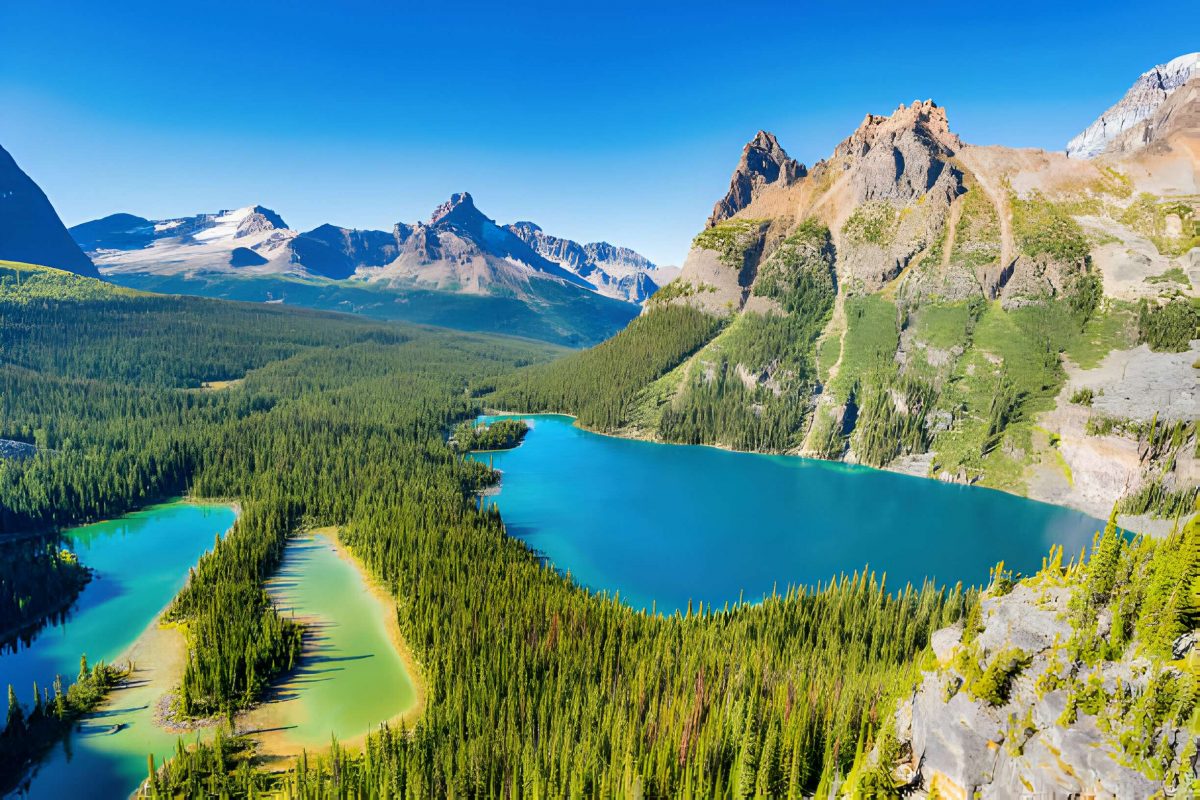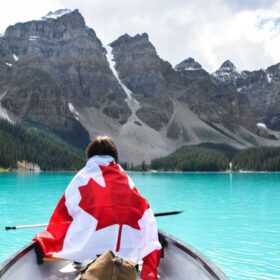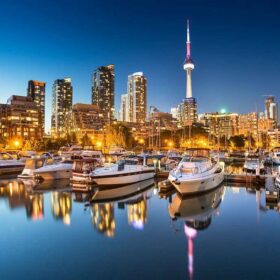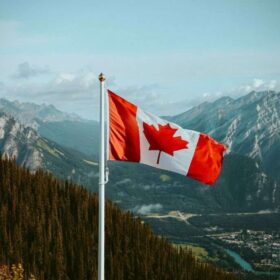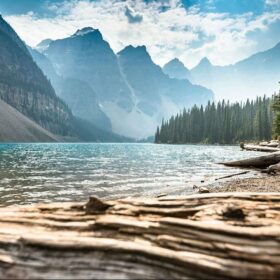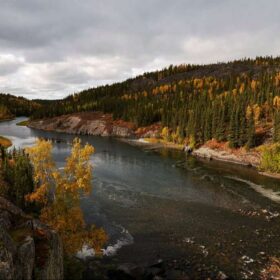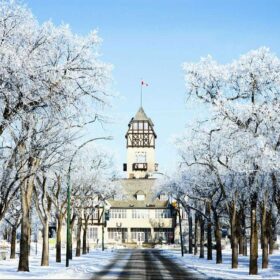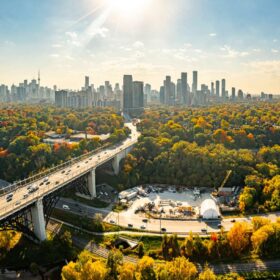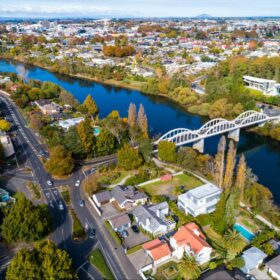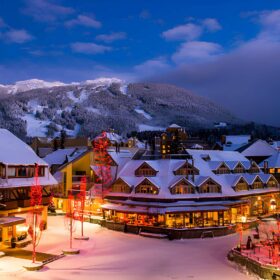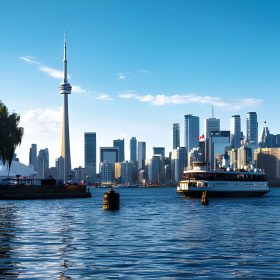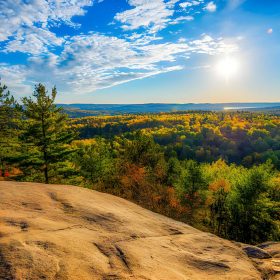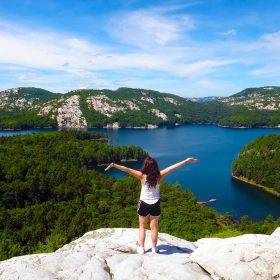Yoho National Park boasts breathtaking mountain scenery, ranking among Canada’s most spectacular national parks. This UNESCO World Heritage Site encompasses a landscape adorned with snow-covered peaks, enchanting lakes, thundering rivers, distant glaciers, and colossal waterfalls. Popular activities in Yoho include sightseeing and hiking.
The park spans a portion of the Rocky Mountains, connecting with both Banff and Kootenay National Parks. The Yoho Valley and the Kicking Horse River area are the key points of interest. The park is conveniently accessible as the Trans-Canada Highway traverses through it.
For trip planning assistance, refer to our list of the best things to do in Yoho National Park.
1. Visit Lake O’Hara
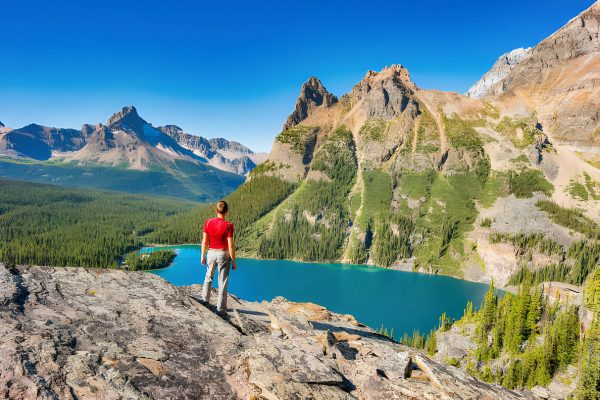
The mesmerizing turquoise Lake O’Hara is widely regarded as the most breathtaking sight in Yoho National Park. Encircled by towering mountains, this stunning locale boasts incredible hiking trails that ascend high above the lake, guiding visitors past smaller bodies of water and waterfalls.
A daily bus service is available to the lake, but there is a daily passenger quota, and reservations are mandatory through a lottery system.
Alternatively, you can opt to hike the 13-kilometer road to the lake, with no access limits for those on foot. Choosing this option requires resilience, as before embarking on any of the spectacular hikes around the lake, you’ll have already covered 13 kilometers and will need to hike another 13 on your way back. Expect a minimum 35-kilometer day, and though the elevation gain isn’t substantial, it is still a significant undertaking. Biking on the road is prohibited.
Nestled on the lake’s shore is the exquisite Lake O’Hara Lodge, while a small park campground sits just back in the woods. Reservations for both can be made online well in advance, typically a year ahead of arrival. A campground reservation includes bus transportation.
2. Hike at Lake O’Hara
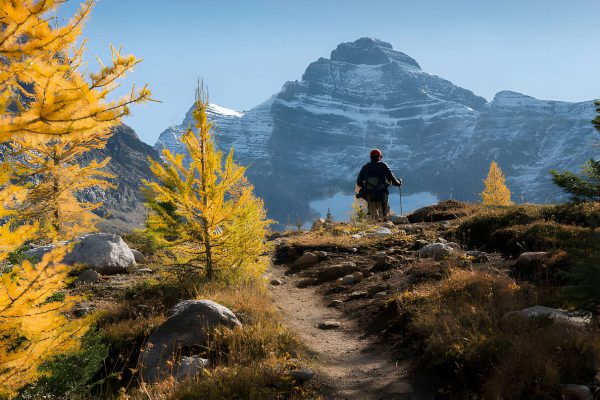
The primary attraction at Lake O’Hara is hiking. While accessing the lake demands careful planning, hikers seeking breathtaking scenery will find it well worth the effort.
The trails encompass a straightforward 2.8-kilometer path around the lake’s shoreline to alpine routes demanding more skill and a full day to complete.
Among the most popular routes are the Lake Oesa Trail, Opabin Plateau Circuit, MacArthur Pass, the Linda Lake Circuit and Morning Glory Lakes, all falling within the moderate to easy difficulty range.
Hiking in this area offers glimpses of waterfalls, upper alpine lakes, and a profound sense of solitude, owing to the limited number of visitors permitted at Lake O’Hara. Occasionally, trails may be closed due to the presence of grizzly bears or other hazards.
3. Camp at Lake O’Hara
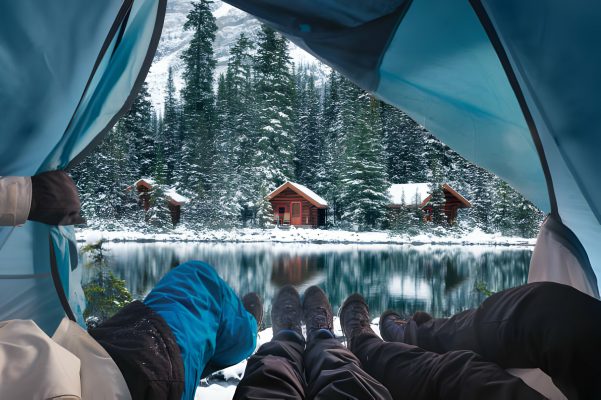
Nestled on the valley floor, surrounded by towering mountains on three sides, the small campground at Lake O’Hara offers 30 coveted sites that require careful planning and a touch of luck to secure. The camping season is limited, running from late June to the 1st week of October.
Conveniently located a short stroll from Lake O’Hara, the campground provides an ideal setting. Once the day trippers have departed, the indescribable sense of serenity envelops this magical place. Take a leisurely walk to the shoreline and witness the mountains changing colors as the sun rises.
Camping here is truly the only way to fully immerse yourself in the spectacular hiking opportunities around the lake. Unlike day trippers, you won’t feel the need to rush back to catch your bus out, allowing you to savor the experience at a more relaxed pace.
4. Hike to Wapta Falls
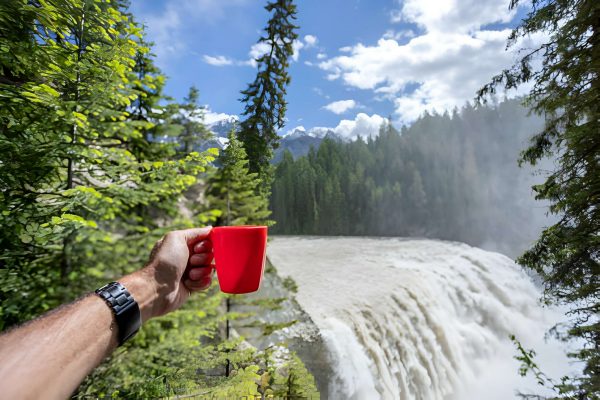
Before the western entrance to Yoho National Park, a side road veers off, concluding after five kilometers at a dead-end. From this point, a trail guides visitors to the magnificent and thunderous Wapta Falls, where the Kicking Horse River plunges 30 meters over a broad rock ledge. Wapta Falls stands as the largest waterfall on the Kicking Horse River.
Access to the falls is granted through a 4.6-kilometer return trail cutting through dense forest. Plan for approximately 1.5 hours of hiking time along a relatively straight path.
5. Natural Bridge
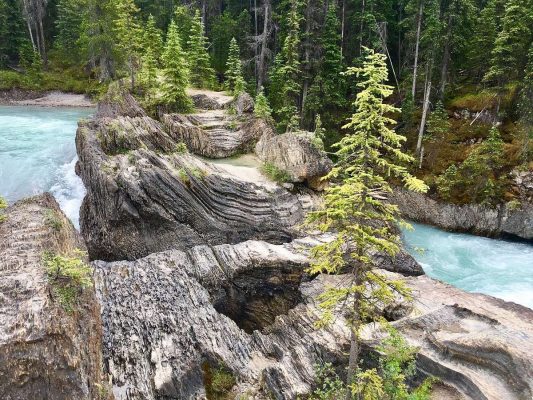
A short distance along the road to Emerald Lake, you will encounter an impressive natural bridge, beneath which the Kicking Horse River flows through highly resistant rock. The natural bridge is easily accessible and not far from the parking lot. A lookout point near the natural bridge offers a close view of the blue waters rushing through the gap.
For a striking photograph, capture the shot straight on from the lookout at the base of the natural bridge. Consider using a long exposure to create a fan-like effect as the water emerges from the narrow chasm.
The turnoff to the Natural Bridge may be easily overlooked, so keep a lookout for it on the left-hand side as you drive into Emerald Lake.
6. Takakkaw Falls
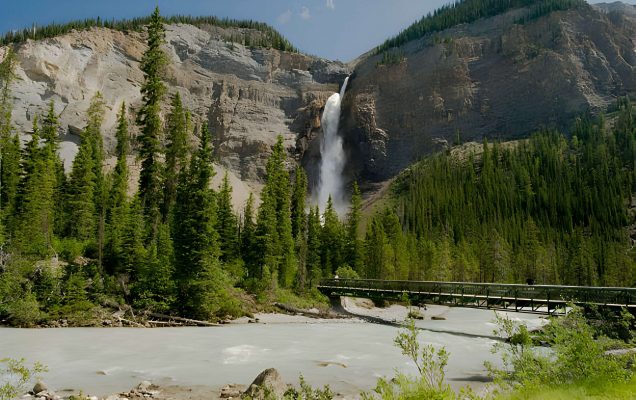
Takakkaw Falls stands as one of the tallest waterfalls in North America, plunging dramatically with a height of 254 meters over a rock face. Standing near the base of the falls, you can gaze directly upward, feeling the mist from the spray as it descends. The waterfall is sourced from the Daly Glacier, a part of the Waputik Icefield.
To reach Takakkaw Falls, take the winding Yoho Valley Road off the TransCanada, leading to the parking lot near the base of the falls. Motorhomes over a certain length are prohibited due to the tight switchbacks.
The views, even from the parking lot, are breathtaking. Additionally, you can stroll up to the stream along the level trail at the base for a complete view of the water cascading from above.
For a higher vantage point, consider the Ice line hiking trail that ascends the mountainside opposite the falls. This moderately strenuous day hike offers a spectacular view over the falls and extends to the glacier beyond. Despite its effort, the hike is well-regarded for the breathtaking panorama and is considered one of the best hikes in Banff National Park.
7. Camp in Yoho National Park
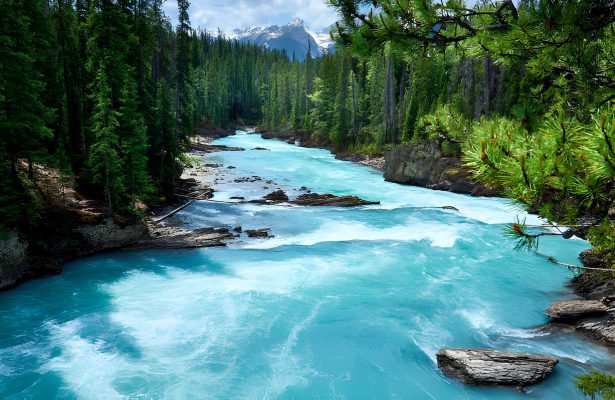
Camping in Yoho National Park offers a spectacular experience with approximately 162 front-country drive-to sites spread across four campgrounds. Additionally, there are 35 walk-to sites available. The camping season typically extends from mid-May to mid-October.
The four primary campgrounds include Kicking Horse, Monarch, Hoodoo Creek, and Takakkaw Falls walk-in. Among these, only Kicking Horse allows reservations; the other three operate on a first-come, first-served basis. All campgrounds are unserviced, lacking water and electricity. Kicking Horse is the sole site equipped with flush toilets and hot showers.
8. Kicking Horse River
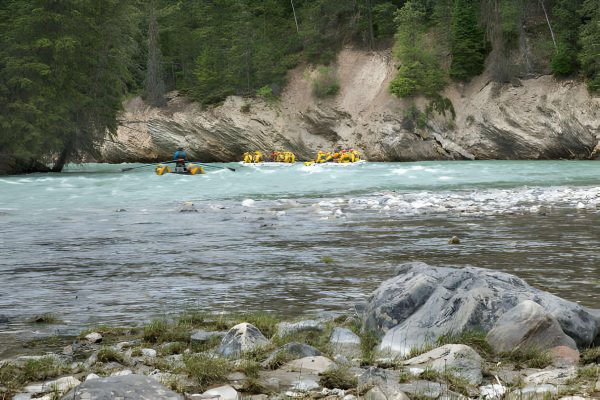
Experience the excitement of white-water rafting in Yoho National Park on the uniquely named Kicking Horse River. This thrilling adventure offers a ride with moments of exhilaration, suitable for participants of all ages, making it particularly family friendly. The rapids vary from level II to IV plus, increasing in intensity as the season progresses.
Rafts come in sizes ranging from 14 feet to 16 feet. White water rafting trips operate from late July until the end of August, featuring glacier-fed water that can be chilly. Full wetsuits and all necessary safety gear will be provided, leaving you to bring nothing but a sense of adventure.
9. Emerald Lake
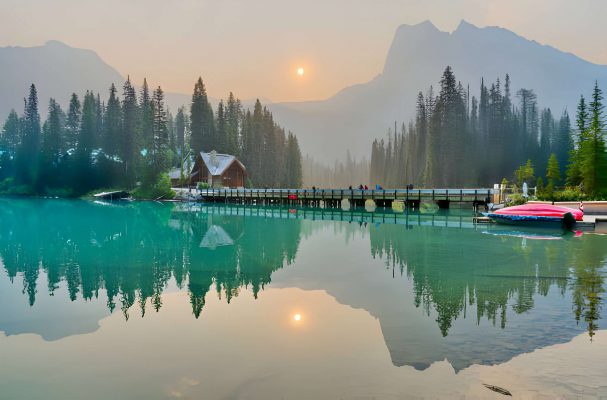
Emerald Lake lives up to its name, showcasing a stunning emerald color amid the glacier-capped mountains of the President Range. Along its picturesque shoreline, a charming resort welcomes guests and visitors, featuring a restaurant open to all.
Various breathtaking hikes commence at Emerald Lake, including the scenic Lake Circuit, the ascents to Yoho and Burgess passes, and the Hamilton Lake trail.
Access to Emerald Lake is available via an eight-kilometer-long road, starting approximately two kilometers south of the town of Field.
Accommodation: Where to Stay in Yoho National Park: Best Areas & Hotels
FAQs:
Q: Is Yoho National Park suitable for families with children?
A: Absolutely! Yoho offers family-friendly activities, easy trails, and educational programs for kids.
Q: What is the best time to visit Yoho National Park?
A: The summer months (June to September) provide the best weather for outdoor activities, but winter offers a unique charm for snow enthusiasts.
Q: Are guided tours available for the Burgess Shale?
A: Yes, guided tours to the Burgess Shale are available, providing insights into the park’s paleontological wonders.
Q: Can I see the Northern Lights in Yoho National Park?
A: While Yoho is not known for the Northern Lights, the Dark Sky program offers an incredible stargazing experience.
Q: Are there accommodations for budget travelers in Yoho National Park?
A: Yes, there are budget-friendly accommodations, including campgrounds and hostels, providing options for every traveler.

